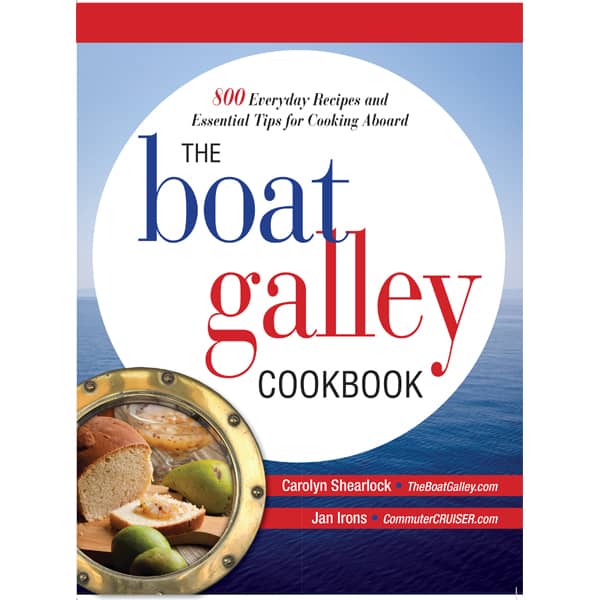Trying to figure out what size and how many propane tanks you need on your boat?
Well, that depends on the size, how much and what types of cooking you do and so on.
A basic rule of thumb is 1 pound per person per week of full-time living.
That assumes:
- “Average” amounts of cooking and baking; few to no electrical appliances such as coffee makers or microwaves
- No particularly cold weather where you cook or bake for long periods to warm up the boat
- No propane refrigeration (with a small propane refrigerator, we used a little over 1 pound a day for two people)
The larger the number of people, the less per person you’re likely to use as cooking time isn’t perfectly proportional to the amount cooked. And single-handers may go through a bit more. But for most families, one pound per person per week is a good starting point.
Many boats use 20-pound tanks, but note that if you do a tank exchange at a store (common in the US), it’s generally only filled with 15 pounds. I get about 2-1/2 months from one of these and just over 3 months with a full 20-pound tank. Some boats use 10-pound tanks to make them easier to carry for refills or exchanges and I’ve seen a couple of boats (who have propane refrigeration, which I really don’t recommend) that have 40-pound tanks.
Whatever size tank you get, I strongly recommend having two so that you can swap tanks instantly when one becomes empty (they always go empty at the least convenient times). The spare tank needs to be kept where any leak will not drain into the boat.
We also do have a gauge on the propane line, which helps us to know that a tank is getting low. A gauge isn’t strictly necessary, but if I’m baking something like bread or a cake where having the tank go empty in the middle would cause funny results (and not just a delay), I’ll check the propane level before lighting the oven and change the tank if it’s virtually empty.
The gauges may not be perfectly accurate, but we’ve had very good luck with them being close to correct (note: some brands get much better reviews than others). Also, when we see the needle starting to drop, we double-check that the spare tank is, in fact, full. All it takes is one morning without coffee and you’ll never forget to check again!

Carolyn Shearlock has lived aboard full-time for 17 years, splitting her time between a Tayana 37 monohull and a Gemini 105 catamaran. She’s cruised over 14,000 miles, from Pacific Mexico and Central America to Florida and the Bahamas, gaining firsthand experience with the joys and challenges of life on the water.
Through The Boat Galley, Carolyn has helped thousands of people explore, prepare for, and enjoy life afloat. She shares her expertise as an instructor at Cruisers University, in leading boating publications, and through her bestselling book, The Boat Galley Cookbook. She is passionate about helping others embark on their liveaboard journey—making life on the water simpler, safer, and more enjoyable.
Simplify meal prep on board with proven strategies for provisioning, maximizing fridge space, and cooking delicious meals aboard your boat.










Anonymous says
Until the pasta is half done!
Anonymous says
That or when you’re in w place where you can’t refill it.
Colin Leake says
HAHA, so true! We ended up with Blue steaks the other night instead of medium rare.
Anonymous says
Depends on how often you use it?
The Boat Galley says
Absolutely! But if you know how long it lasts for full-timers, you can extrapolate to weekends to two-week trips, etc.
Anonymous says
I think the most useful thing about the post is in the picture above. Get a good pass-through gauge and then you can actually SEE not only where your fuel level is at, but perhaps also indicate how much fuel was expended when you use a particular appliance (stove/heat, etc) for a certain period of time.
Anonymous says
My wife wants to know if I can be fitted with one of these gauges?
The Boat Galley says
🙂
Anonymous says
Until it’s empty
Anonymous says
Ours has managed to last a year plus…but always seems to run out ON Thanksgiving while we are trying to cook dinner….and of course we always think it won’t so don’t get a spare tank! LOL
Anonymous says
We still have no idea!!
Anonymous says
We stay weekends only now and we were praying it didn’t go out in the middle of cooking. It has lasted us months. Thanks for the good rule of thumb.
Anonymous says
That’s the same as asking how long is a piece of string
Bob Viscount says
We use almost exactly 1 lb./person/week with the exception of heating for winter live-aboards, at 15 F. we used 3 lbs./day with a “little Buddy” not running at night. We have two 8.5 lb aluminum tanks and fill one when the other is empty that way we don’t run out of hot coffee. I would have 10 lbs. but they don’t fit where ours are. For the winter heat we used two 10 lb steel tanks, but if we do it again I’ll use twenty lb. not too much trouble since we are obviously not sailing around.
Laney Gale says
Quick tip to see how much is left, pour boiling water down the side of the tank, then quickly run your hand down the side of the tank, where the tank is warm there is no gas but you will feel the tank cold around where the gas is!
David NORMAN says
In my opinion it is not how long a bottle of gas lasts but making sure you have a full bottle ready to be able to change over to a full bottle. Nothing worse than not being able to boil the jug for a nice hot coffee. Be disciplined to refill the empty bottle asap.
Anonymous says
We bought a luggage scale (a little handheld scale with a spring). If we are wondering if we should fill up while we’re near a refilling station, we just weigh the scale to see how much propane is left.
The tare weight is printed on the tank.
The scale was very handy when we were using our propane heater every day this winter and didn’t have historical data on how fast we’d go through it.
Jane Head says
Carolyn,
We have an adapter that allows us to attach a 1 lb propane can (we keep a couple of these on hand for the gas grill and a little propane heater) to our regular propane line. Not ideal but in a pinch…
Gary A Green says
We live aboard and my girlfriend cooks every day, but doesn’t do much baking. We heat water for coffee in an electric coffee maker, but everything else cooked / heated uses propane.
We have an 11 gallon tank and it lasts us approximately 5 months.